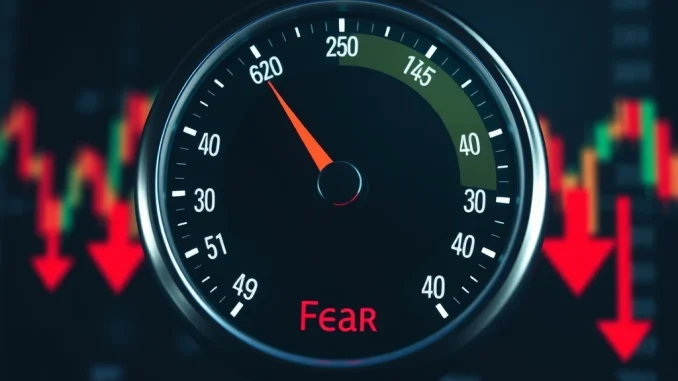
Are you feeling a knot of anxiety in your stomach when you check your crypto portfolio? You’re not alone. The latest reading of the Crypto Fear & Greed Index is flashing a stark warning sign, plunging to 29 as of April 16th. This nine-point drop from the previous day isn’t just a minor fluctuation; it firmly plants us back in the ‘Fear’ zone, according to Alternative.me.
Decoding the Crypto Fear & Greed Index: What Does ‘Fear’ Really Mean?
Think of the Crypto Fear & Greed Index as a mood ring for the cryptocurrency market. It’s a single number, ranging from 0 to 100, designed to distill the complex emotions swirling within the crypto sphere. A score of 0 screams ‘Extreme Fear,’ suggesting investors are panic-selling, while 100 exuberantly shouts ‘Extreme Greed,’ hinting at a potential market bubble. Currently, at 29, we’re firmly in ‘Fear’ territory. But what does this actually mean for you, the crypto enthusiast?
Essentially, a ‘Fear’ reading suggests that investors are becoming increasingly cautious, possibly anticipating price drops or market corrections. It’s a reflection of market sentiment, driven by a mix of real-world events, market analysis, and good old-fashioned investor psychology. Understanding this sentiment is crucial for navigating the volatile world of cryptocurrencies.
What Factors Fuel the Crypto Fear & Greed Index?
This isn’t just some random number plucked from thin air. The Crypto Fear & Greed Index is a carefully constructed metric, taking into account six key factors to gauge the overall crypto market sentiment. Let’s break down what goes into this crucial index:
- Volatility (25%): This measures the current and maximum drawdowns of Bitcoin and other cryptocurrencies, comparing them to average values over the last 30 and 90 days. High volatility often breeds fear.
- Market Momentum/Volume (25%): This factor compares the current market momentum and trading volume against the 30 and 90-day averages. Strong momentum can indicate greed, while weak momentum can signal fear.
- Social Media (15%): This analyzes sentiment trends on social media platforms, primarily Twitter and Reddit, related to cryptocurrencies. Are people buzzing with excitement or expressing concern?
- Surveys (15%): While currently paused, this factor previously involved conducting weekly crypto polls to gauge investor sentiment directly.
- Bitcoin Dominance (10%): Bitcoin’s dominance in the overall crypto market is a key indicator. Increased Bitcoin dominance can sometimes suggest a ‘flight to safety’ during fearful times.
- Google Trends (10%): This analyzes Google Trends data for various Bitcoin-related search queries. Spikes in searches like “Bitcoin crash” can indicate fear, while searches for “buy Bitcoin” might suggest greed.

Navigating the ‘Fear Zone’: What Should Crypto Investors Do?
Seeing the Crypto Fear & Greed Index dip into the ‘Fear’ zone can be unsettling, but it’s not necessarily a cause for panic. In fact, savvy investors often see periods of fear as potential opportunities. Here’s a balanced perspective on how to approach the current crypto fear:
Potential Opportunities in Fear:
- Buying Opportunity?: Legendary investor Warren Buffett famously said, “Be fearful when others are greedy and greedy when others are fearful.” A ‘Fear’ reading can sometimes signal a potential buying opportunity. When sentiment is low, prices might be undervalued, presenting a chance to accumulate assets at a discount.
- Market Correction is Healthy: The crypto market is known for its boom-and-bust cycles. Corrections, even sharp ones, are a natural part of market dynamics. They can help to cool down overheated markets and set the stage for more sustainable growth.
- Focus on Fundamentals: During periods of fear, it’s crucial to revisit your investment strategy and focus on the fundamentals of the projects you’re invested in. Are the underlying technologies still strong? Is the adoption growing? Solid fundamentals can weather short-term market sentiment swings.
Cautions to Consider During Fear:
- Emotional Decisions: Fear can lead to impulsive selling decisions. It’s essential to avoid making emotional reactions based solely on the Fear & Greed Index. Stick to your long-term investment plan.
- Further Downside Risk: While ‘Fear’ can present opportunities, it also signals genuine market uncertainty. There’s always a possibility of further price declines. Risk management and diversification are key during these times.
- External Factors: Remember that the crypto market sentiment is influenced by broader economic factors, regulatory news, and global events. Keep an eye on these external influences as well.
Is it Time to Panic or Strategize Amid Crypto Fear?
The drop in the Crypto Fear & Greed Index to 29 serves as a clear indicator of heightened crypto fear within the market. However, it’s vital to remember that this index is just one tool in your investment toolkit. It reflects collective sentiment, but it doesn’t predict the future.
Instead of panicking, view this ‘Fear’ reading as a valuable piece of information. Use it to reassess your portfolio, reinforce your risk management strategies, and potentially identify strategic buying opportunities if you believe in the long-term potential of the cryptocurrency market. By understanding the dynamics of market sentiment and the factors driving the Crypto Fear & Greed Index, you can navigate these uncertain times with greater confidence and make informed decisions, rather than being swayed by pure emotion.



